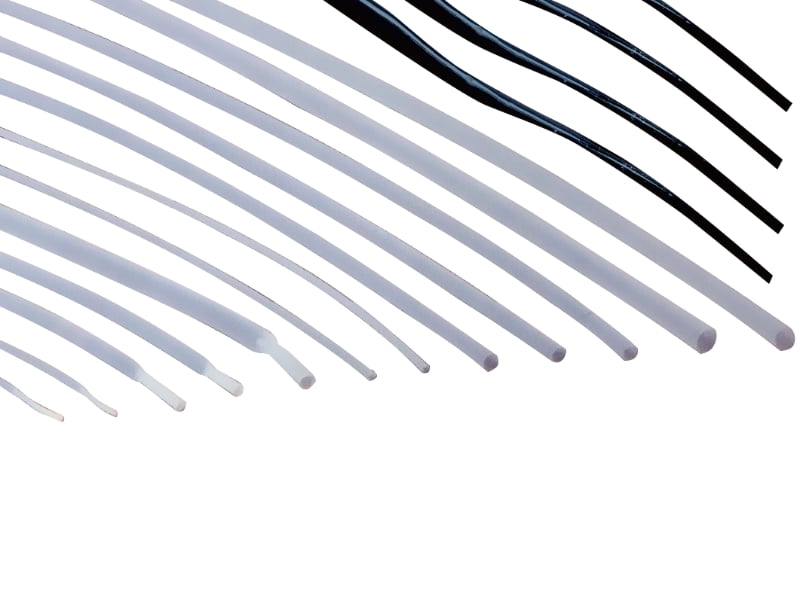أنابيب PTFE قابلة للتقلص الحراري: الخصائص والتطبيقات والصيانة
مقدمة
الأنابيب القابلة للتقلص الحراري من البولي تيترافلوروإيثيلين (PTFE) هي نوع متخصص من أنابيب البوليمر الفلوري المعروفة بخصائصها الحرارية والكيميائية والكهربائية الاستثنائية. على عكس أنابيب PTFE التقليدية ، تخضع أنابيب PTFE القابلة للتقلص الحراري للتوسع الشعاعي أثناء التصنيع ، مما يسمح لها بالتقلص مرة أخرى إلى أبعادها الأصلية عند تعرضها للحرارة. هذه الخصائص الفريدة تجعلها لا تقدر بثمن في الصناعات التي تتطلب عزل دقيق وحماية وختم.

الخصائص الرئيسية للأنابيب PTFE قابلة للتقلص الحراري
1. الاستقرار الحراري
أنابيب PTFE قابلة للتقلص الحراري تعرض مقاومة حرارية متميزة، مع نطاق درجة حرارة التشغيل المستمر من -200 درجة مئوية إلى +260 درجة مئوية قدرة التعرض على المدى القصير تصل إلى 300 درجة مئوية . نقطة ذوبانها تقريبا 327 درجة مئويةويحافظ على الاستقرار الأبعاد حتى في درجات الحرارة المبردة. الموصلات الحرارية للمادة هي 0.25 واط / م · كيساهم في خصائص العزل الممتازة.
2. المقاومة الكيميائية
يظهر الأنابيب الخمول الكيميائي شبه العالمي ، ويقاوم جميع المواد الكيميائية الصناعية والمذيبات والأحماض ، بما في ذلك حمض الكبريت المركز والأكوا ريجيا. تظل ثابتة العازلة مستقرة في 2.1 على نطاق واسع من الترددات (10Hz إلى 2.45GHz )، مع عامل التبديد من 0.0002 في 1MHz.
3. الخصائص الميكانيكية
مع قوة الشد من 20-35 ميجا باس وإطالة عند كسر 200-400% ، أنابيب التقلص الحراري PTFE تقدم المتانة الميكانيكية الرائعة. معامل الاحتكاك منخفض بشكل استثنائي في 0.05-0.10وتدابير الطاقة السطحية 18.5 داين / سم ، وضمان الأداء غير اللاصق.
4. الأداء الكهربائي
تتباهى المادة بمقاومة حجم >1018 Ω·cm والقوة العازلة من > 40 كيلو فولت / مم . تتجاوز مقاومة القوس 300 ثانية (ASTM D495) ، مما يجعلها مثالية لتطبيقات الجهد العالي.
5. تقلص الخصائص
أنابيب التقلص الحراري PTFE القياسية عادة ما تحقق نسبة التقلص 2: 1 ، مع بدء التقلص في حوالي 175 درجة مئوية وانكماش كامل يحدث في 300-320 درجة مئوية - تدابير قوة الإنعاش 0.5-1.5 ميجا باس ، وضمان تناسب مطابقة ضيقة.
تطبيقات أنابيب PTFE قابلة للتقلص الحراري
1- الطيران والدفاع
في أنظمة أسلاك الطائرات ، تحمي أنابيب التقلص الحراري PTFE إلكترونيات الطيران الحساسة من درجات الحرارة القصوى (-65 درجة مئوية إلى 200 درجة مئوية) والسوائل الهيدروليكية. خصائص الانبعاث المنخفضة (<0.1% TML, <0.01% CVCM per NASA outgassing standards) make it suitable for space applications.
2. Medical Devices
The tubing serves as insulation for electrosurgical instruments, withstanding repeated sterilization cycles (autoclaving at 134°C) while maintaining biocompatibility (USP Class VI, ISO 10993 certified). Its non-stick surface prevents tissue adhesion in minimally invasive surgical tools.
3. Semiconductor Manufacturing
Used in wafer processing equipment, the tubing resists ultra-pure chemicals like HF acid and provides particle-free protection for sensitive components. Its purity level meets SEMI F57 standards with extractable metals <1 ppb.
4. High-Voltage Electrical Systems
As insulation for bus bars and high-voltage connectors (up to 50kV), PTFE tubing prevents corona discharge with its high dielectric strength ( > 40 كيلو فولت / مم) and tracking resistance (CTI >600V).
5. Chemical Processing
The tubing protects sensors and instrumentation in aggressive environments, resisting permeation from chemicals like chlorine (permeation rate <0.01 g·mm/m2·day).
Installation and Maintenance Guidelines
1. Proper Installation Techniques
For optimal performance:
Select tubing with 20-30% larger recovered diameter than the substrate
Clean surfaces with isopropyl alcohol (≥99% purity) before installation
Use controlled heat sources (hot air guns at 300-350°C or infrared heaters)
Apply heat uniformly, rotating the part to ensure even shrinkage
Allow gradual cooling to room temperature (20-25°C/min cooling rate)
2. Maintenance Procedures
To extend service life:
Inspect annually for mechanical damage (abrasion >10% wall thickness requires replacement)
Clean with compatible solvents (e.g., perfluorohexane or perfluoroketones)
Monitor for chemical degradation (contact angle measurement <100° indicates surface degradation)
Store in controlled environments (15-25°C, 40-60% RH, away from UV light)
3. Troubleshooting Common Issues
Address typical problems:
Incomplete shrinkage: Increase temperature in 25°C increments up to 350°C maximum
Bubbling: Reduce heating rate to <50°C/min
Delamination: Ensure substrate temperature is >150°C before shrinking
Contamination: Use particle-free handling (cleanroom ISO Class 5 or better)
PTFE heat shrinkable tubing represents the pinnacle of performance in critical insulation and protection applications. Its unique combination of properties enables solutions where other materials fail, particularly in extreme environments. Proper selection, installation, and maintenance ensure optimal performance throughout its service life.



 English
English

